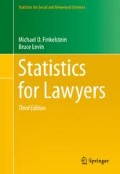Abstract
Many probability puzzles can be made transparent with knowledge of a few basic rules and methods of calculation. We summarize some of the most useful ideas in this section.
Access this chapter
Tax calculation will be finalised at checkout
Purchases are for personal use only
Notes
- 1.
In infinite sample spaces, an event with probability 0 may still occur if the infinitude of possibilities is non-denumerable. For example, when a dart is thrown at a target, the probability that any specified point will be hit is zero because points have zero width, but still the dart hits the target at some point.
- 2.
This is Bonferroni’s first inequality. More generally, if A 1, · · , A n are n events, the probability of the union of A 1, · · · , A n is obtained as follows: first, take the sum of each event separately, \( {\displaystyle \sum_iP\left[{A}_i\right]} \); second, subtract the sum of all pairwise joint probabilities \( {\displaystyle \sum_{i\ne j}P\left[{A}_i\cap {A}_j\right]} \) since the previous sum overestimates the union’s probability; next, add back the sum of all joint probabilities in triples, \( {\displaystyle \sum_{i\ne j\ne k}P\left[{A}_i\cap {A}_j\cap {A}_k\right]} \), since the previous step overcorrected slightly. Continue in this way by alternately subtracting and adding sums of joint probabilities until one adds or subtracts the final term \( P\left[{A}_1\cap \cdots \cap {A}_n\right] \). At any stage, the probability of the union may be approximated by the terms included up to that point, incurring an error no larger than the magnitude of the first omitted term.
- 3.
When defendants were arrested, the woman’s hair was light, not dark, blond and the man did not have a beard. There was some evidence that the man had altered his appearance after the date on which the offense had been committed. The car was only partly yellow.
- 4.
It is unclear how a hair could be similar to more than one of nine mutually dissimilar hairs.
- 5.
The introduction of population frequency statistics, without Bayes’s theorem, does not require jurors to come up with a numerical probability of guilt, but the Minnesota Supreme Court equated the Bayesian and non-Bayesian scenarios by focusing on the risk that jurors would misread the population statistics as just such a quantification.
- 6.
The difference between these events can be made clear from an example attributed to Keynes. If the Archbishop of Canterbury were playing in a poker game, the probability that he would deal himself a straight flush, given honest play on his part, is not the same as the probability of honest play on his part, given that he has dealt himself a straight flush. The first is 36 in 2,598,960; the second most people think would be much larger, perhaps close to 1.
- 7.
Assuming random misclassification errors and with a “positive” outcome defined as two or more individual positives.
Author information
Authors and Affiliations
Rights and permissions
Copyright information
© 2015 Springer Science+Business Media, LLC
About this chapter
Cite this chapter
Finkelstein, M.O., Levin, B. (2015). Elements of Probability. In: Statistics for Lawyers. Statistics for Social and Behavioral Sciences. Springer, New York, NY. https://doi.org/10.1007/978-1-4419-5985-0_3
Download citation
DOI: https://doi.org/10.1007/978-1-4419-5985-0_3
Publisher Name: Springer, New York, NY
Print ISBN: 978-1-4419-5984-3
Online ISBN: 978-1-4419-5985-0
eBook Packages: Mathematics and StatisticsMathematics and Statistics (R0)

